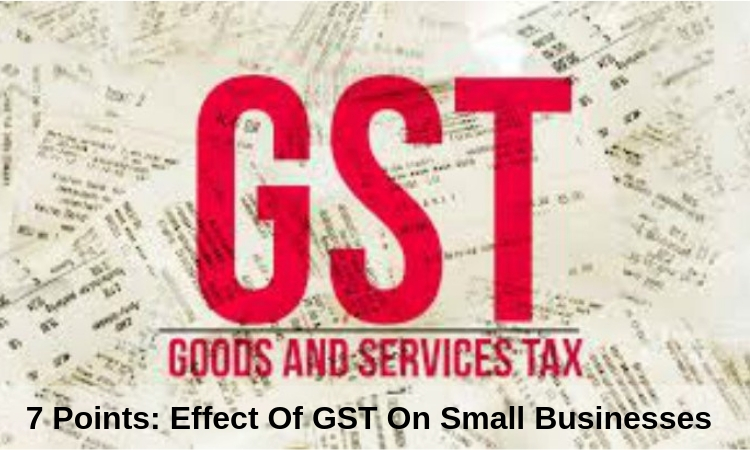7 Points: Effect Of GST On Small Businesses

The implementation of the Goods and Services tax affected large corporations as well as small businesses. All commercial organizations and individuals had to get GST registration for new business and make arrangements for fulfilling the new compliance requirements. In this article, we are discussing the effect of GST on small businesses. The initial months of the new tax were marked by a malfunctioning GST network system and other troubles. It took some time before things settled down and people got the hang of the new system and its multiple tax slabs. The small and medium enterprises are a vital part of the Indian economy and make major contributions to its growth. Let’s see how this sector has been impacted by the new indirect tax.
Table of Contents
1. Easy To Start A New Business
The process to start a new business has become a little simple as compared to the older tax regime. Earlier a new business had to get a registration for the Value Added Tax (VAT) with the sales tax department of the state where it wanted to locate its facilities. If the new company was running operations in more than one states, it had to get separate VAT registration in each location. Even now, companies have to get GST registration in each state where they are involved in the supply of services. However, things have become simpler because of uniform GST rules across the whole country instead of different state VAT regulations.
2. Advantage Of Simple Tax Structure
With the introduction of the new tax system, a lot of older taxes were eliminated. This removed the cascading effect of multiple taxes that was seen earlier. Businesses had to factor in central levies like excise duty, customs duty, service tax, etc. and state taxes such as VAT and octroi. This meant a higher final price of a product and the business owner had to deal with multiple authorities for paying the taxes. The new system is completely digital and taxpayers have to file returns on the GST portal and do not need to keep track of multiple taxes.
3. Higher Exemption Limit
The new law required businesses with an annual aggregate turnover of more than Rs 20 lakhs to pay the tax and get the GST registration. This new threshold limit was higher than that of different VAT registration limits of various states. Some of them had set the figure at Rs 10 lakhs while others had finalized Rs 5 lakhs annual turnover as the cut-off figure for VAt registration. Additional relief was announced when the GST Council in its 32nd meeting decided to raise the exemption limit to Rs 40 lakhs. This has led to many small enterprises and startups being relieved of the burden of complying with the new law. They do not need to engage GST consultants in India or other professionals to register for the tax.
4. Reduced Logistics Cost
One of the biggest effects of GST on small businesses has been in the area of logistics. The earlier tax structure with multiple levies had led to the creation of checkpoints at state borders. Moreover, an inter-state supply of goods required a lot of paperwork and payment of taxes. This hampered the smooth flow of goods and increased the logistical costs for enterprises. The enactment of the new tax ended the border check-post system and multiple levies. This has quickened the transfer of goods and reduced the costs. It has been a welcome change for small and medium enterprises.
5. Advantage Of Composition Scheme
Small business owners have been provided a benefit in the form of the composition scheme. When the tax was rolled out, entities with a turnover below Rs 1 crore were allowed to pay the tax at a fixed rate of their turnover. Now the limit has been raised to Rs 1.5 crore and suppliers of service as well as mixed suppliers in the unorganized sector have also been made eligible for the scheme. The compliance requirements of composition dealers have also been made easy. They have to pay quarterly taxes but need to file only one annual return. All these changes have been made earlier this month and before that such taxpayers had to file 4 quarterly returns.
6. Facility To Claim Input Tax Credits
Another notable feature of the new tax is the facility to businesses for claiming an input credit on an already paid tax. This is similar to the earlier system of claiming VAT input credit. This allows companies to reduce their tax burden when they are paying levies on an output by deducting the tax already paid on inputs. This is a beneficial feature for small enterprises and startups. However, petroleum products which are a vital input item in most manufacturing sectors are not included in GST which stops many businesses from claiming input credits on the levies paid on this expensive category of goods.
7. Increased Burden Of Compliance
The burden of compliance has increased for all GST-eligible taxpayers. They have to take the assistance of GST consulting services to register their business in states where they are involved in supplying a service. Companies with operations in multiple states have to get separate registrations in each location. Moreover, depending on the nature of their business, they have to file monthly, quarterly or annual returns. This has increased the number of documents they have to maintain for the purpose. However, the entire process is conducted online through the GST Network meaning taxpayers do not have to physically visit offices to pay taxes or file returns.
Conclusion
The impact of GST on small businesses has forced many operators to get the necessary registration. However, with the threshold limit being raised, many startups and small firms have been exempted from paying the new tax.







Awesome!!! Nice post